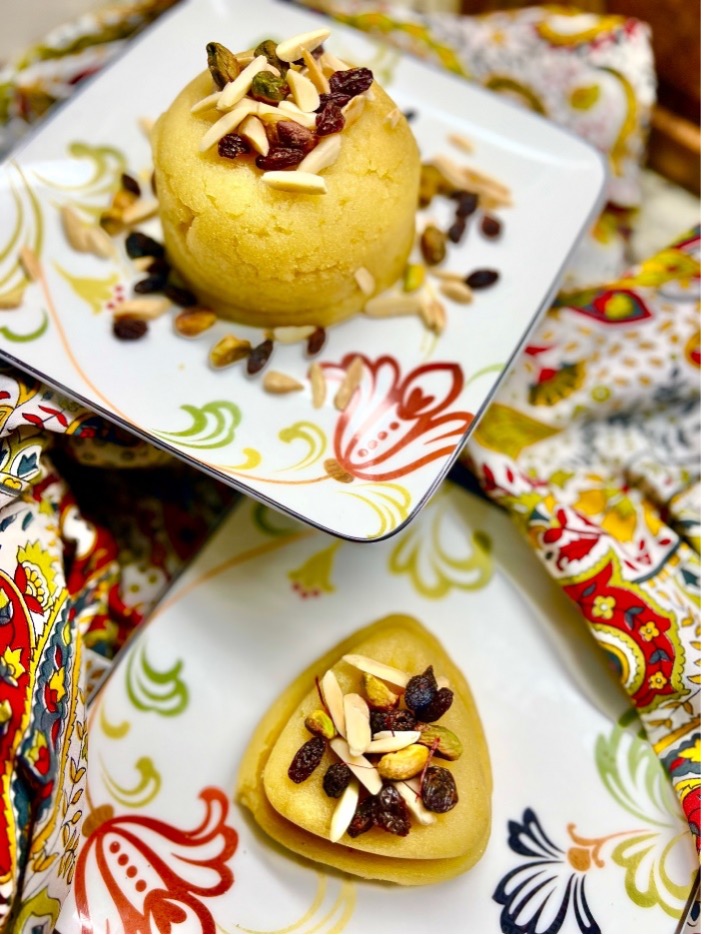
The Proven Platter—Afghanistan, March 2024
Afghan cuisine is as rich and varied as the history of Afghanistan. Its place as the “heart of Asia” has meant that many Asian culinary traditions are found enmeshed in Afghan culinary traditions. Some of these traditions were born in the Afghan soil and spread through the region, others assimilated from elsewhere. Imagine my surprise at finding “Sooji Halwa” featured as a popular Afghan dessert. After all, I had grown up eating this dessert, by that very same name, in South India. It was ubiquitous in India, made at every special occasion and an absolute must at every wedding feast. Halwa (or halva), I soon learned, is derived from the Arabic word “Hulw” meaning “sweet” and that the the first codified recipe for Halwa appeared in an Arabic book “Kitab al-Tabikh” (The Book of Dishes) authored by Muhammad bin Hasan al-Baghdadi in 1226. Colleen Taylor Sen, a food historian writes in her book “Feasts and Fasts” that the Halwa made its way to India through Persia between the 13th – 16th century. So there it was, the Halwa, the very many manifestations of it, beloved in India was a contribution of Afghan cuisine.
In honor of our Afghan grantee, this month I bring you one of the easier to make Halwas – the Sooji Halwa. In Afghan tradition, this semolina pudding is made with a sugar syrup, flavored with cardamom and saffron, and garnished with dried fruit and nuts – all ingredients that are quintessentially Afghan. It is what I call a “high return on investment” dish. Other than the saffron, all ingredients are pantry staples and the prep time is about 20 minutes. The only “laborious” part, if that, involves the continuous stirring of the semolina mixture.
It can be served hot, at room temperature, or cold. It can be served just dished out on to ramekins or plates or fancied up by shaping it using molds. It sets as it sits (like polenta) and my mum would spread it when hot in a baking tray and then cut into small diamond shaped little bites of sweet deliciousness. I invite you to serve it as you feel moved to.
Afghan Sooji (Semolina) Halwa
Serves: 6
Ingredients:
2 cups water
1 cup sugar
Saffron, a pinch
½ teaspoon cardomom powder
1 cup semolina
4 tablespoons butter
3 tablespoons raisins
3 tablespoons slivered almonds
2 tablespoons pistachios
Equipment:
Sauce pan
Skillet
Instructions:
Toast the raisins, slivered almonds, and pistachios on low heat. Set aside.
To the sauce pan on high heat, add 2 cups water. When the water comes to a boil, reduce the heat and add the sugar. Stir until the sugar dissolves and forms a syrup like consistency. Add the saffron and cardamom powder to the syrup and stir. Set the sugar syrup aside.
Set the skillet on medium flame. When the skillet is hot, add the cup of semolina and stir. A fair amount of stirring is required to ensure that the semolina is toasted. It should lose its raw flour aroma and gain a slighty nutty flavor. Care should be taken to ensure that the semolina doesn’t burn.
When the semolina is toasted, add the butter and stir to combine. Stir until the semolina and butter mixture is completely combined. At this point it will be a little crumb-like.
Add the sugar syrup, a little at a time and quickly stir until it is fully combined and has a silky, pudding-like consistency (think polenta, but a little thinner).
Remove from the heat. The pudding will set as it sits.
Garnish with the toasted dried fruit and nuts. This dish be served warm or cold, scooped into ramekins or on to dessert plates, or allowed to set in molds and served.
Recipe and photo credit: Vinola V. Munyon
